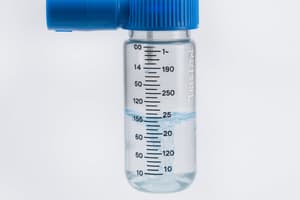Podcast
Questions and Answers
ในอุตสาหกรรมการบิน ทำไมการไหลของอากาศด้านบนของปีกเครื่องบินเป็นไปได้
ในอุตสาหกรรมการบิน ทำไมการไหลของอากาศด้านบนของปีกเครื่องบินเป็นไปได้
- สร้างหลักปฏิบัติการของการบิน
- สร้างประสิทธิภาพความดันสูง (correct)
- สร้างพื้นที่ความดันต่ำ
- สร้างความเสถียรภาพของเครื่องบิน
ระบบไฮดรอลิคใช้อะไหล่ไหนในการถ่ายโอนแรงจากที่ตั้งไปยังที่อื่น
ระบบไฮดรอลิคใช้อะไหล่ไหนในการถ่ายโอนแรงจากที่ตั้งไปยังที่อื่น
- ของเหลวที่อยู่ในสภาพแรงดัน (correct)
- ลมที่ถูกกด
- ผ้าใยแม๊กซ์
- เหล็กแข็ง
ใช้วิธีใดเพื่อสร้างช่องท่อแหล่งกำเนิดแรงดันต่ำในเครื่องยนต์จีนขับเคลื่อน
ใช้วิธีใดเพื่อสร้างช่องท่อแหล่งกำเนิดแรงดันต่ำในเครื่องยนต์จีนขับเคลื่อน
- หัวเชื้อเพลิง (correct)
- ลมแรง
- เส้นใยแม๊กซ์
- พุ่มไฟ
การใช้กำลังแรงเพื่อหยุดล้อรถยนต์ในระบบเบรกไฮดรลิคเป็นตัวอย่างของ
การใช้กำลังแรงเพื่อหยุดล้อรถยนต์ในระบบเบรกไฮดรลิคเป็นตัวอย่างของ
ในการดำเนินการของโรงงานอาหารและเครื่องดื่ม แรงกดที่สำคัญที่มีประโยชน์คืออะไร?
ในการดำเนินการของโรงงานอาหารและเครื่องดื่ม แรงกดที่สำคัญที่มีประโยชน์คืออะไร?
เทคโนโลยีที่ใช้ลมแรงกดเพื่อหมุนต่างหากที่ให้พลังงานกับเครื่องถ่ายไฟฟ้าคือ?
เทคโนโลยีที่ใช้ลมแรงกดเพื่อหมุนต่างหากที่ให้พลังงานกับเครื่องถ่ายไฟฟ้าคือ?
เครื่องมือทางการแพทย์ที่ใช้ความกดในการวัดความดันเลือดคือ?
เครื่องมือทางการแพทย์ที่ใช้ความกดในการวัดความดันเลือดคือ?
ในการสกัดน้ำมันและก๊าซ แรงกดมีบทบาทสำคัญในขั้นตอนใด?
ในการสกัดน้ำมันและก๊าซ แรงกดมีบทบาทสำคัญในขั้นตอนใด?
หลายประเภทของเครื่องจักรใช้พลังงานแรงจากแรงกดของลม ตัวอย่างเช่น การขุดผลิตสินค้า การสร้าง และการเกษตร มีประโยชน์จาก?
หลายประเภทของเครื่องจักรใช้พลังงานแรงจากแรงกดของลม ตัวอย่างเช่น การขุดผลิตสินค้า การสร้าง และการเกษตร มีประโยชน์จาก?
ในการสร้างหลุมบ่อ ต้องใช้อุปกรณ์ใดเพื่อขับเครื่องจักร?
ในการสร้างหลุมบ่อ ต้องใช้อุปกรณ์ใดเพื่อขับเครื่องจักร?
Study Notes
Exploring Applications of Pressure in Engineering
We're diving into the fascinating realm of แรงดันในแกน—pressure as it applies to engineering—and discovering how this fundamental concept powers solutions across a wide variety of fields.
The Basics of Pressure
Pressure is the force per unit area that a substance exerts on the surface it's in contact with. In simpler terms, it's like how a stack of books pushes down on the table.
Applications in Engineering
Engineers leverage pressure in numerous ways to create devices, systems, and tools that improve our lives. Some of these applications include:
Aviation
Commercial airliners and rocket engines rely on pressure to achieve lift and thrust. In an airplane's wing, air flows faster over the top, creating high pressure and generating lift. Meanwhile, rocket engines push through the exhaust nozzle, creating a low-pressure area that draws in fuel and propels the vehicle forward.
Hydraulics
Hydraulic systems use pressurized fluids to transfer force from one location to another. For example, the hydraulic brakes in your car convert the pressure from the brake pedal into a force strong enough to slow the wheels and bring the vehicle to a halt.
Pneumatics
Pneumatic systems use pressurized air or other gases to transfer force. For instance, the air compressor in a pneumatic drill converts electrical energy into mechanical force by increasing the pressure of air inside the drill, which then drives the drill bit to create holes.
Fluid Power
Fluid power systems, including hydraulics and pneumatics, are essential in modern engineering. They are used in industrial applications such as machinery, manufacturing, construction, agriculture, and transportation.
Gas Turbines
Gas turbines use pressurized air to turn a turbine that drives a generator, producing electricity. This technology is commonly used in power plants and jet engines.
Food and Beverage Production
Pressure plays a vital role in food and beverage manufacturing, with applications such as canning, pasteurization, and brewing.
Medical Devices
Pressure is a critical factor in medical devices, including blood pressure monitors, dialysis machines, and respirators.
Oil and Gas Extraction
Pressure is a core aspect of oil and gas extraction, and the technologies used to explore, drill, and produce hydrocarbons rely heavily on understanding and controlling pressure.
The Future of Pressure in Engineering
As technology advances, engineers continue to innovate and develop new applications that harness the power of pressure. With the upcoming release of features like Bing Chat's "No Search" option, engineers can now more easily integrate pressure-based systems into AI-powered solutions, further accelerating the potential of this fundamental concept.
So, the next time you're flying in an airplane or enjoying a can of soda, remember the fascinating role that pressure plays in engineering these and countless other daily experiences.
Studying That Suits You
Use AI to generate personalized quizzes and flashcards to suit your learning preferences.
Description
Delve into the world of pressure in engineering, from its fundamental definition to its diverse applications in aviation, hydraulics, pneumatics, fluid power, gas turbines, food and beverage production, medical devices, and oil and gas extraction. Learn how pressure powers technological advancements and shapes everyday experiences.




